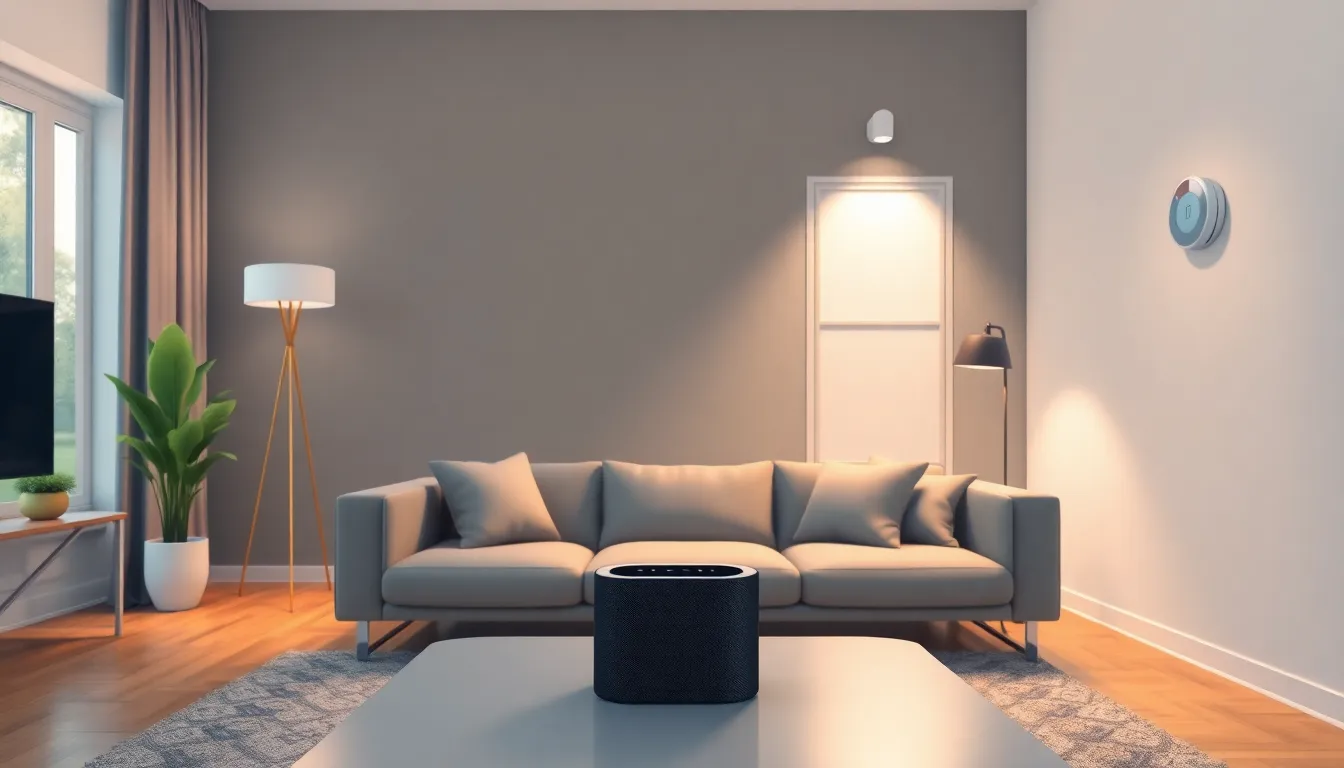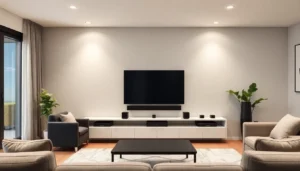Table of Contents
ToggleImagine waking up to the gentle hum of your coffee maker brewing the perfect cup before your feet even hit the floor. Sounds like magic, right? Welcome to the world of smart homes, where convenience meets innovation and your home practically anticipates your every need. With a few clever tweaks, you can transform your living space into a tech-savvy haven that not only makes life easier but also impresses your friends and family.
Understanding Smart Homes
Smart homes integrate advanced technology to enhance everyday living. These homes utilize devices connected to the internet, allowing seamless operation and control. Homeowners control lighting, temperature, and security systems through smartphones or voice commands.
Automation plays a crucial role in smart homes, adjusting settings based on user preferences. Programmable thermostats maintain optimal temperatures automatically. Smart lighting systems can be set to dim or brighten based on the time of day. Voice assistants, such as Amazon Alexa or Google Assistant, enable hands-free control of various devices.
Security is a significant aspect of smart homes. Many systems offer real-time surveillance and alerts via cameras and motion sensors. With smart locks, homeowners can monitor and control access remotely. Notifications sent directly to smartphones enhance security awareness.
Energy efficiency stands out in smart home technology. Smart appliances optimize energy use, helping to lower utility bills. Smart plugs allow users to track energy consumption and reduce waste. Homeowners can program devices to operate during off-peak hours for cost savings.
Interconnectivity remains a defining feature of smart homes. Devices communicate with one another, creating a cohesive system that responds to user commands. For instance, a smart thermostat can lower the temperature when a smart doorbell detects no one is home. Such integrations create a more efficient and user-friendly environment.
Embracing smart home technology enhances comfort, security, and efficiency. Many options allow for customized setups tailored to individual needs. Exploring different devices and systems can lead to a smarter, more convenient living space.
Benefits of Smart Home Technology

Smart home technology offers numerous advantages that transform everyday living. Increased convenience ranks among the foremost benefits of automation.
Increased Convenience
Smart devices simplify daily tasks. Smart speakers let users play music or set reminders hands-free. Automated lighting adjusts based on time or occupancy, saving time during evenings. Programmable appliances such as ovens and coffee makers preload settings, enabling effortless meal preparation. Homeowners can also control everything remotely via mobile apps, ensuring ease even when away. Ultimately, these features create a seamless living experience that enhances quality of life.
Enhanced Security
Security stands as a critical benefit of smart home devices. Smart cameras provide real-time surveillance and send alerts if any unusual activity occurs. Homeowners can check video feeds remotely, ensuring peace of mind during absences. Additionally, smart locks enable keyless entry, allowing residents to grant access to guests or service personnel from anywhere. Integrated alarm systems detect potential intrusions and notify homeowners promptly. Overall, these enhancements contribute to a safer environment.
Energy Efficiency
Energy efficiency significantly improves with smart technology. Smart thermostats adapt heating and cooling based on occupancy patterns, optimizing energy consumption. Automated plugs and appliances monitor usage and suggest cost-saving measures. Users can track energy usage via apps for informed decisions about electrical consumption. With intelligent systems in place, homes experience reduced utility bills and a lower environmental footprint. These efficient practices promote sustainable living while increasing comfort.
Essential Smart Home Tips
Smart homes provide a wealth of opportunities for enhancing daily life. These tips will guide you in getting the most out of smart technology.
Choose the Right Hub
Selecting an appropriate hub is fundamental for any smart home setup. A hub facilitates communication between devices, ensuring they operate smoothly together. Examples of reliable hubs include Samsung SmartThings and Amazon Echo Plus. Compatibility plays a significant role, as not all devices work with every hub. Investing time in research yields better integration and a coherent smart home experience.
Invest in Quality Devices
Quality devices enhance performance and longevity. Smart home devices, such as cameras and thermostats, vary widely in price and features. Choosing well-reviewed products maximizes functionality, like energy efficiency and security. Trusted brands often offer better customer support and updates. Shopping for high-quality devices means considering features that meet specific needs, ensuring satisfaction in the long run.
Prioritize Compatibility
Compatibility should remain a top priority when selecting smart devices. Some brands work better together, leading to a more seamless experience. Platforms like Apple HomeKit or Google Assistant streamline device management. Avoiding compatibility issues saves time and frustration later on. Researching devices before purchasing guarantees that they will integrate smoothly into the smart home ecosystem.
Automating Your Home
Automating a home transforms daily routines into seamless experiences. Smart technology provides opportunities for efficiency and convenience.
Setting Up Routines
Establishing routines simplifies home management. Create customized schedules for lighting, heating, and appliances. For instance, set outdoor lights to activate at sunset and indoor lights to dim at bedtime. Additionally, programming a coffee maker to brew each morning offers a pleasant start to the day. Use a smartphone app to easily adjust these routines based on lifestyle changes or special occasions. Smart thermostats also adapt heating and cooling based on set schedules, enhancing comfort while conserving energy.
Integrating Voice Assistants
Utilizing voice assistants amplifies smart home capabilities. Devices like Amazon Echo or Google Nest Hub allow hands-free control over various appliances. Users can issue commands to adjust lighting, lock doors, or check security cameras without physical interaction. Voice assistants integrate with other smart home systems, creating a more user-friendly environment. Commands for multiple devices can occur simultaneously, enhancing efficiency. For example, saying “Goodnight” can turn off all lights and secure the front door. Streamlined control through voice interaction reinforces convenience and accessibility in automated homes.
Maintaining Your Smart Home
Maintaining a smart home involves consistent care and attention to technology, ensuring optimal performance and security.
Regular Software Updates
Regular software updates keep devices functioning properly. Updates often provide bug fixes and performance enhancements, improving user experience. Many manufacturers schedule these updates automatically, but checking frequently ensures devices run on the latest version. Users can typically find update options in the device settings. Whether it’s a smart thermostat or security camera, maintaining current software enhances compatibility with new features.
Ensuring Security Protocols
Ensuring security protocols safeguards a smart home against threats. Strong passwords form the first line of defense against unauthorized access. Enabling two-factor authentication adds another layer of security, making it harder for intruders to breach systems. Regularly monitoring connected devices for suspicious activity remains critical. Users can configure alerts for unauthorized access attempts, enhancing overall safety. Ultimately, prioritizing cybersecurity measures strengthens the overall integrity of a smart home system.
Conclusion
Embracing smart home technology offers a transformative experience that enhances daily living. By integrating automation and connectivity, individuals can create a space that not only meets their needs but also elevates their lifestyle. Prioritizing device compatibility and quality ensures a seamless experience while maximizing the benefits of convenience, security, and energy efficiency.
Regular maintenance and security practices are essential for optimal performance. By staying proactive with updates and monitoring, users can enjoy a safe and efficient smart home environment. As technology continues to evolve, the potential for personalization and innovation in smart homes will only grow, making it an exciting time to invest in this modern approach to living.



